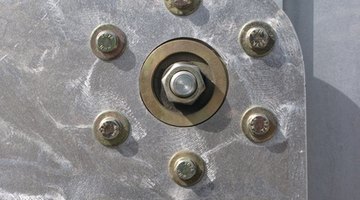How Tight Should Bolts Be Tightened
Tightening a bolt seems straightforward, but there are several different methods, depending on what kind of bolt you're tightening. In general, you should make the bolt tight enough so that the items it is holding together stay together, but not so tight that you damage the bolt's threads. You should tighten bolts properly so that the bolt performs properly.
Torque

Some bolts require that you tighten them to a specific torque level. To find out if you have one of these bolts, and what that specific torque is, you should check with the bolt's manufacturer. Correct torque is usually most important if the item you're securing with a bolt is essential for your safety; for example, the wheel on a car.
When a bolt is tightened properly, the shank of the bolt sustains direct stress due to the torque acting on the threads. This stress also causes the bolt to stretch a bit, minimizing the chance that it will break because of the lack of slack between the bolt head and the item being secured.
If you know that the bolt you're using is at risk for loosening over time due to vibration, you should use a torque prevailing fastener to help you achieve optimum torque instead of trying to over-tighten the bolt.
Using a Wrench
The most common way to tighten a bolt is to use a wrench and the "sense of feel" method, which means you tighten the bolt until it just feels right to you. This system is straightforward, but you can never be sure about the final bolt tension load, or the torque. The wrench itself could also damage the bolt assembly, and re-loosening and tightening the bolt can increase this damage, leading to bolt failure.
Other Methods
If you want to be absolutely certain about how tight to tighten your bolt, you should know that there are electronic systems available commercially that contain control systems that are sensitive to the torque gradient of the bolt being tightened, and so know when to stop tightening the bolt. The control system has sensors that read the torque and the angle of the bolt during the tightening process to determine how much to tighten the bolt for optimum performance.
There is also a special bolt available called a RotaBolt that lets you know how much force to use when tightening it. The RotaBolt uses a central gauge pin that is installed in a hole in the center of the bolt that spins while you're tightening the RotaBolt. When you're tightening the bolt, its fastener stretches elastically, but the gauge pin will eventually stop being able to move. As you continue tightening, the RotaBolt stretches enough to eliminate the gap between the pin and the bolt head at the optimum torque level and prevent the bolt from tightening any further.



